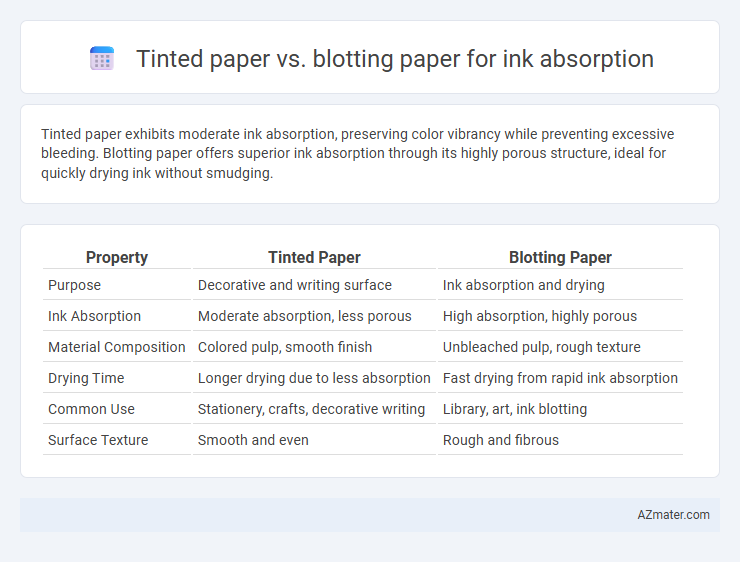Tinted paper exhibits moderate ink absorption, preserving color vibrancy while preventing excessive bleeding. Blotting paper offers superior ink absorption through its highly porous structure, ideal for quickly drying ink without smudging.
Table of Comparison
| Property | Tinted Paper | Blotting Paper |
|---|---|---|
| Purpose | Decorative and writing surface | Ink absorption and drying |
| Ink Absorption | Moderate absorption, less porous | High absorption, highly porous |
| Material Composition | Colored pulp, smooth finish | Unbleached pulp, rough texture |
| Drying Time | Longer drying due to less absorption | Fast drying from rapid ink absorption |
| Common Use | Stationery, crafts, decorative writing | Library, art, ink blotting |
| Surface Texture | Smooth and even | Rough and fibrous |
Introduction: Understanding Tinted Paper and Blotting Paper
Tinted paper features a colored surface designed primarily for aesthetic appeal and reducing glare, whereas blotting paper is porous and engineered specifically for rapid ink absorption and drying. Blotting paper's fibers and texture enable efficient absorption, preventing smudging and ensuring clean ink lines. The distinct manufacturing processes result in tinted paper offering limited ink absorption, contrasting with blotting paper's superior ink control properties.
Composition Differences: Tinted vs Blotting Paper
Tinted paper is typically composed of cellulose fibers with added pigments or dyes integrated during manufacturing, designed primarily for aesthetic appeal and controlled ink spread. Blotting paper, made from highly absorbent, loosely bonded cellulose fibers, lacks pigments and is engineered to rapidly absorb excess ink without smudging. The fundamental composition difference lies in the inclusion of tinting agents in tinted paper versus the pure, highly porous fiber network of blotting paper optimized for maximum ink absorption.
How Ink Absorption Works on Tinted Paper
Tinted paper absorbs ink through its porous surface fibers, which control the spread and drying time of the ink by varying the fiber density and coating composition. Unlike blotting paper, which is designed to rapidly soak up excess ink due to its high absorbency and loose fiber structure, tinted paper manages ink absorption to maintain color vibrancy and prevent bleed-through. This precise absorption mechanism on tinted paper ensures sharper lines and enhanced visual appeal in printing and writing applications.
Blotting Paper: Specialized Properties for Ink Absorption
Blotting paper features a highly porous texture designed to rapidly absorb excess ink, preventing smudging and ensuring clean, sharp writing results. Its specialized cellulose fiber structure enhances ink absorption by drawing moisture away from the surface, which makes it superior to tinted paper for drying and ink control. Unlike tinted paper, which primarily serves aesthetic purposes, blotting paper is engineered specifically for functionality in ink absorption.
Comparative Ink Drying Times
Tinted paper generally shows slower ink drying times compared to blotting paper due to its denser surface and coating that reduce ink absorption rate. Blotting paper, made from highly absorbent fibers with a porous structure, rapidly soaks up excess ink, significantly accelerating drying times. This makes blotting paper ideal for preventing smudging and facilitating quick ink setting, especially in fountain pen usage.
Effects on Ink Color and Clarity
Tinted paper can alter the perceived hue and vibrancy of ink, sometimes dulling bright colors or shifting tones due to its inherent color filter effect. Blotting paper excels in absorbing excess ink quickly, preventing smudging but potentially causing slight diffusion that may soften fine details and reduce sharpness. Choosing between tinted and blotting paper depends on whether preserving true ink color or ensuring crisp drying without smears is the priority for the intended artwork or writing.
Suitability for Fountain Pens and Calligraphy
Tinted paper often offers smoother surfaces and reduced glare, enhancing ink flow and preventing feathering, making it suitable for fountain pens and calligraphy with finer nibs. Blotting paper excels in rapid ink absorption, preventing smudging and providing quick drying, ideal for heavier ink loads and broad strokes typical in calligraphy. Choosing between the two depends on desired ink control versus drying speed, with tinted paper favoring precision and blotting paper enhancing efficiency in ink management.
Archival Qualities and Longevity
Tinted paper often contains dyes or pigments that can affect ink absorption by altering surface texture and acidity, potentially compromising archival qualities and leading to faster degradation over time. Blotting paper is specifically designed with high absorbency and low acidity, making it ideal for quickly soaking up ink, reducing smudging, and preserving the integrity of documents with enhanced longevity. For archival purposes, blotting paper's pH-neutral composition and fiber structure provide superior protection against ink bleed and paper deterioration compared to tinted paper.
Best Practices for Choosing Paper Based on Ink Type
Tinted paper often absorbs ink differently depending on the dye composition, making it ideal for pigment-based inks that require less spreading and clearer lines. Blotting paper excels in rapid ink absorption, especially with water-based inks, preventing smudging by quickly soaking excess ink from writing surfaces. Selecting paper based on ink type ensures optimal drying time and sharpness, with tinted paper suited to dye and pigment inks and blotting paper best for managing moisture in water-based ink applications.
Conclusion: Selecting the Right Paper for Optimal Ink Absorption
Tinted paper offers moderate ink absorption with minimal bleeding, ideal for artistic projects requiring color contrast, while blotting paper excels in rapid ink absorption, preventing smudges during writing or calligraphy. Blotting paper's porous texture effectively soaks up excess ink, enhancing drying times and clarity, whereas tinted paper balances aesthetics with functional ink handling. For optimal ink absorption, choose blotting paper for practical ink control and tinted paper for visual appeal combined with sufficient absorption.

Infographic: Tinted paper vs Blotting paper for Ink absorption
 azmater.com
azmater.com